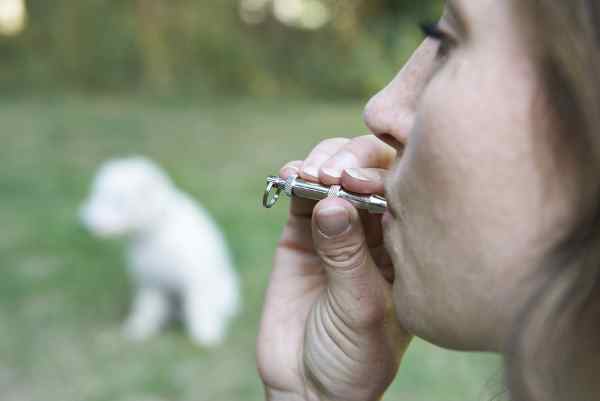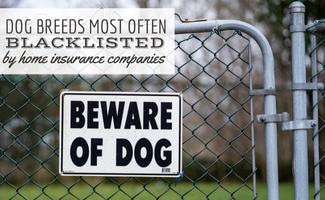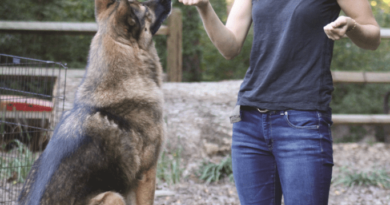Just How Much Do You Know About Dog Whistle Training?
Dog Whistle Training by Adarsh Gupta Updated 08-11-2022
You have probably seen how wonderfully some shepherds use a dog whistle to send across several signals and instructions to their sheep guard dogs. They use the whistle to send across instructions like surrounding the herd of sheep, putting them inside the pen, taking them out to the field and arranging them without losing anyone.
These shepherd dogs are trained to follow all the instructions through different frequencies and pitches of the whistle. However, this is not an inbuilt trait that these dogs have, and it requires a right amount of training.
From understanding the pitches to co-relating it with different commands, a dog needs to be trained in all the aspects of the whistle.
 Dog Whistle Training
Dog Whistle TrainingAt present, a lot of dog trainers use whistles to train their dogs and teach them various tricks.
From commands like, ‘sit,’ ‘stand,’ ‘fetch,’ ‘stop,’ your dog can be trained for different commands using different pitches and frequencies.
For proper training, the prime requisite that you need to have is the right kind of whistle and the patience to let your dog learn in their own time, without stressing them out.
If you too are wondering how to use a dog whistle effectively, this article may help you out.
The History of Dog Whistle Training
Training dogs with dog whistles is not a new trend. It goes back to decades. Centuries ago, dog whistles were only used by shepherds who utilized them to signal their guard and herding dogs.
Later, it was used by hunters. Hunters used the whistle to call their retriever dogs, to fetch and to change the direction. The sound of the whistle travels faster, and it also does not startle the potential prey. They used different pitches for different commands. However, today the dog whistles used are much advanced.
At present, dog trainers use whistles to train different tricks. Many dog owners have also adopted this practice, as it helped them in teaching their pup various methods and making them behave well.
How does a dog whistle work?
The hearing ability of a dog is much superior to humans. For humans, the audible range of sound frequency is from 20 hertz (Hz) to 20,000 Hz; whereas, for dogs, it is between 40 Hz and 60,000 Hz, which is almost twice that of humans. When it comes to dog whistles, the frequency falls between the range of 23,000 to 54,000 Hz.
Their superior hearing is due to dogs’ outer ear flaps. There are over 18 muscles in the dogs’ ear flaps. This enables them to position their ear canal and hear loud and clear. Thus, they can listen to the dog whistle from a distant and can follow the sound accordingly.
What is a ‘silent’ whistle?
The silent dog whistle is also known as Galton’s whistle. Sir Francis Galton invented it. This whistle emits an ultrasonic sound, which is not audible to human ears.
The frequency of the most common ‘silent’ whistle is around 35,000 Hz, which is beyond the scope of the human hearing. Most dogs hear this sound. These whistles are best when you do not want to disturb anyone near you while training your pup. However, the only drawback is that you might also attract few other dogs of your neighborhood without any intention.
Which dog whistle to choose?
If you look for dog whistles online, you will come across a wide array of whistles with different features. Given below are few widely acclaimed types:
1. Whistles with Adjustable Frequencies
These whistles are made of stainless-steel. The adjustable frequency lets you use the sound that suits your puppy.
2. Whistle with Set Frequency
These whistles are one of the most widely used. They are very easy to use and also very long-lasting.
How to Use a dog whistle effectively?
- Once you get a suitable dog whistle for your puppy, you need to adjust the pitch to which your puppy responds.
- Everyday training is very crucial; as you would not want your pup to forget the tone of the whistle. This will also make your puppy familiar with the sound.
- You need to give different pitches for different cues. Your puppy needs to understand the different frequencies, to understand what he is expected to do, without making them confused.
- Always keep some treats with you while training. If your dog follows your instruction, reward them with a treat. This will encourage them to become more attentive.
- You can also use the whistle to teach them proper behavior. If your puppy is naughty or if you have two puppies fighting, you can use the whistle to stop them right away.
When to use a dog whistle?
Using a dog whistle to train your puppy is much more effective than your voice, as the frequency of the whistle helps in making them more attentive.
Moreover, the whistle will not have the emotional sound of your voice and can be used for different tricks, without making the pup puzzled.
You surely want your pup to be obedient and well-behaved. The dog whistles can help you with that. Make them realize if their act is not acceptable and if they are naughty.
With the right amount of training, you will notice that your pet is changing into a perfect dog.
Below I’ve included a few basic training instructions that you can teach your pup with the help of a dog whistle.
Dog Whistle Training
The recall command, “Come”
Here you can teach your pup to come to you, every time you sound the whistle. It can usually be a long hard blow or a series of short ones. Deciding on the frequency depends on your dog’s nature.
You will need to blow the whistle and call out his name.
Repeat it every time you want to call them towards you. This will make them realize that every time they hear that sound, they need to come to you.
This will further help you in taking your puppy out for a walk without the leash.
Dog Whistle Training: The Sit command
To teach them the sit command using a whistle, you may start with one long blast. Here, you need to have your pup closer to you at the beginning, so that they can also hear the verbal command to sit.
Later you can use the whistle from a distance. If your puppy gets the command right, do not forget to treat them!
Dog Whistle Training: The Direction Change Command
This is usually used for hunting or retriever dogs. It can be a long trill noise. Let them know that they need to change the direction.
Initially, you will have to follow them or run along with them to make them understand what the command is. And of course, treat them!
The Good Behavior Command
Here you need to let your pup free from the leash and let them roam freely. Watch them where they go and how they behave. If you see them being naughty or misbehaving, you need to blow the whistle hard.
This will make them alert and will let them know that they need to stop whatever they are doing. After the loud whistle, follow it with the calling command. If they listen, treat them again!
To know more about whistle training, you may also opt for professional trainers. They will let you know all the tricks and treats that will keep your puppy attentive and engaged when it comes to whistle training.
Things to Consider With Dog Whistle Training
If you are planning to getting a dog whistle for your puppy, there are certain things you need to note. Not every dog may follow the whistle training rapidly. Under such circumstance, you must have a lot of patience with them.
Experiment with Different Frequencies and Whistles
You may have to try different frequencies and also different types of whistles to get the perfect one for your mutt.
Dog Whistle Training Should be Positive
If you use the whistle as a punishment, your dog may stop responding to it. Make sure you use it for positive behaviors.
Also every time they follow your whistle instruction, rewarding them with treats may encourage them. You need to know how to balance the usage of the dog whistle.
If your dog has a reserved and timid nature, the whistle may shut them off. Give them time to understand the sound and show them love. Let them realize that the noise is not a threat. Treat them if they follow and go slow.
You and Only You are the Trainer
Be the only master. Do not let everyone or anyone blow the whistle and command them. This will confuse them further, and they might not follow the instructions.
Things You Should Not do When Dog Whistle Training
Remember that your dog has more sensitive hearing than you. Therefore, never blow the whistle right into their ears. This will damage their hearing and may make them scared. Loud noises can also make them stressed. So, try to start the training with a soft and gentle blow to make them familiar with the sound.
The dog whistle is not a magical tool. Do not consider it to be the ultimate training weapon. Some dogs may learn fast, and some may take a longer time to get used to the sound and follow the commands. Have patience, while training. If your dog is not able to follow your instructions in a week, it does not mean that you have failed in training them.
Tips that will help you master dog whistle training
- Start by training them in a room or a playground where there is no other distraction.
- Always carry treats with you so that you can reward them after they follow the instructions.
- Have the whistle around your neck, so that it is easily accessible to you.
- If your dog is distracted, blow the whistle and let them come to you with their curiosity. Let them investigate the sound.
- If they come to you after hearing the first blow, reward them with a treat so that they know it is something they are expected to do.
- Do not give, into the begging of treats. You need to make them understand that they need to earn it by doing what they are instructed to do.
- Train them every day at a specific time. So, that they are ready for the training and know what they are supposed to do.
- Repeat the session at least 5 times a day to make it a habit for them, but keep it short.
- Their reward treats should be exclusive; something that they do not get except during training sessions
Dog Whistle Training: Author Bio
Adarsh Gupta is
a proud father of 2 Pomeranians and 2 French Bulldogs, and always looks forward
to sharing all his thoughts about dogs with other dog parents. He also makes
recommendations on all kind of breed and their training in his sites: pupfection.com and toppuppytraining.com.
Does This Article Deserve Your Thumbs Up?
We always appreciate your support and encouragement. Your thumbs up means so much to us. Please like this article.
If you find this page or any page on Small Dog Place Helpful, or Useful in anyway, I’d love it if you would click the small heart found on the bottom right of each page.
You can also share or bookmark this page — just click on the:

Free Monthly Newsletter
Sign Up for Our Free Newsletter and get our Free Gift to You.
my E-book, The Top 10 Mistakes People Make When Choosing a Dog (and how to avoid them)







